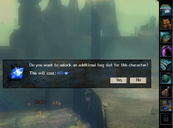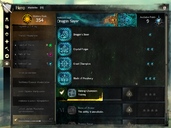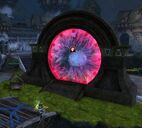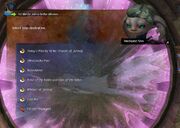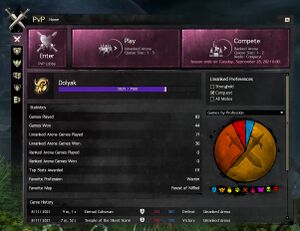Endgame
Endgame refers to the content intended for players after they reach the maximum level on their character. While Guild Wars 2's open world uses Dynamic level adjustment so that high-level players can still play in low-level zones, most of the endgame content is restricted for max-level characters.
Guild Wars 2's endgame content is varied but can be categorized as follows, further developed below in the body:
- Progression-based content — improving equipment, training masteries, unlocking elite specializations, mounts etc.
- Combat-based content — subdivided into open world and instanced PvE content, Structured PvP game mode, and World versus World mode.
- Story and exploration-based content — playing new story chapters found in expansions and Living World episodes or doing map completion.
- Cosmetic-based endgame — unlocking dyes, gear skins, mount skins, glider skins, or legendary equipment with its unique features and visual effects.
- Achievements and Community — which can take the form of socializing through Guilds or pursuing achievements and titles.
Progression-based content[edit]
Unlike many similar games, Guild Wars 2 lacks a gear treadmill (where new gear sets are added periodically making previous gears obsolete). Instead, the driving philosophy is horizontal progression, in which players can achieve non-numerical bonuses via the Mastery system, cosmetics, or Elite Specializations. This progression can occur on both a character-wide and account-wide level.
Character progression[edit]
A character that has reached maximum level is only at the start of their journey.
- Elite Specializations
These are trait lines that open up new worlds of possibility for each profession. The expansions ![]() Heart of Thorns,
Heart of Thorns, ![]() Path of Fire, and
Path of Fire, and ![]() End of Dragons each introduced an elite specialization to each profession.
End of Dragons each introduced an elite specialization to each profession. ![]() Elementalists can become
Elementalists can become ![]() weavers to attune to two elements at once,
weavers to attune to two elements at once, ![]() thieves can become
thieves can become ![]() deadeyes to snipe their foes with precision,
deadeyes to snipe their foes with precision, ![]() engineers can summon Jade Mech CJ-1 as
engineers can summon Jade Mech CJ-1 as ![]() mechanists , and so on.
mechanists , and so on.
Each elite specialization requires 250 hero points to fully unlock it, with each hero challenge in expansion maps providing 10 of those points.
- Equipment and builds
One of the first goals of a level 80 character should be to get a full set of gear of the desired attribute combination, together with runes and sigils. Equipment of Exotic rarity is often easy and inexpensive to obtain through the Trading Post or World vs. World vendor and is enough to welcome players into the endgame. As players progress, they will begin their journey towards Ascended equipment, the best gear in the game. It is obtained either through crafting or as a reward for participating in endgame activities, particularly in instanced PvE like Fractals of the Mists, raids, and Strike Missions. Legendary equipment is just as powerful as Ascended but has additional quality-of-life improvements in the form of being available to all characters in the account through the Legendary Armory, having the option to change its attributes freely at any point, or remove its upgrades or change its cosmetic appearance without cost.
Equipment attributes, together with traits, weapons, and utility skills, create a build, which determines the effectiveness of a character. New players might want to consult external guides and builds before starting their gearing process and venturing into the endgame.
Furthermore, all professions have several builds with different goals in the endgame. A player might need power based gear for one build, and healing for another, so the gearing process is pivotal to the endgame.
- Other considerations
Beyond that, there are other things that contribute to character progression:
- Inventory size can be maximized by using bigger bags on a character, and even further by purchasing Bag Slot Expansions (Default price: 400 Gems). The biggest bags increase the inventory size by 32 slots. Note that bag slots are character bound and unlocking more on one character doesn't add bag slots to other characters.
- Learning a crafting discipline allows players to create their own gear and/or food.
Account progression[edit]
Guild Wars 2 also focuses on account progression, a set of features that, once unlocked, become available to all characters in the account.
The mastery system is the main account-wide progression system, providing all characters of the account with benefits such as gliding, mounts, etc. In essence, masteries work like a levelling system, except instead of getting character levels, players earn different passive effects, abilities or are able to access new content.
- Primary article: Mastery
- Other considerations
- Shared Inventory Slots are shared between all characters, so players can put in them items that they will want every character to have access to.
- Such items might be lounge passes, such as Invitation to "Lily of the Elon"; salvagers, like Copper-Fed Salvage-o-Matic; converters, like Herta or Princess; contracts, like the Permanent Bank Access Contract; or other varied gizmos such as the Prototype Position Rewinder or the White Mantle Portal Device.
- Account bonuses, such as Magic find or Gold Find.
- The commander tag that allows players to broadcast their location on a map and lead massive organised groups of players. It will also make organising a raiding squad easier.
- Account bound gear can be used by any character, even the armor if it's of the required weight. All Ascended and Legendary gear is account bound.
- Account unlocks and convenience items from the Gem Store such as Bank Tab Expansions, Permanent Contracts or unlimited Gathering tools or Salvage kits.
- Account-bound consumables such as Tomes of Knowledge can also be collected to increase the leveling speed of a new character.
- The Home instance can be enriched with many Nodes that can be gathered daily.
- Amassing currencies, such as gold, to progress on other goals. They are stored in the account-wide wallet.
Combat based content[edit]
Guild Wars 2 features three different combat game modes: PvE, sPvP, and WvW.
Player versus Environment[edit]
- See also: Player versus Environment
Shortened as PvE, in this content players fight against NPCs and the environment. While PvE is a very wide term that encompasses things such as story or world bosses, the endgame focuses on the following:
- Open world events
Meta events and map meta events are large-scale battles where a large number of players, or even every single player on the map in some cases, work towards a common goal. Many of these events are on a global timer, which can be consulted in Event timers, have a low or non-existent entry barrier, and are the first step in the PvE endgame.
- Fractals of the Mists
- Primary article: Fractals of the Mists
Fractals of the Mists have taken over dungeons in instanced 5-player group PvE. Fractals are short, repeatable, rewarding, and have an innate progression system. They feature 4 different tiers of difficulty, progressively introducing more mechanics known as instabilities to shake things up. Fractals are the perfect stepping stone for PvE players as they progress through the easy tier 1 fractals into the hardcore tier 4 fractals with challenge motes.
To progress into harder and more rewarding Fractals, players will need to equip Agony Infusions in their gear to resist the Agony of higher-level fractals. Players possess a Personal Fractal Level, which is the highest level fractal they can open by themselves, though they can enter any fractal opened by another player. Fractals of the Mists can be accessed from Lion's Arch near the Fort Marriner Waypoint and from Mistlock Sanctuary.
- Raids
- Primary article: Raids
Raids are 10-player squad-based PvE instances focused on challenging combat and mechanics and require owning their respective expansion. Each raid encounter typically utilises multiple phases with several unique mechanics which test the squad's coordination, damage output, and positioning. It is the most challenging PvE content in the game in terms of required skill, alongside challenge motes in Strike Missions and Fractals of the Mists. The main hub for all raids is the Lion's Arch Aerodrome. Some fights require certain masteries from at least a few members of the squad to complete the encounter.
Daunting for lacking an innate progression system and sometimes having a high barrier to entry in the LFG tool, the community has come together to offer raid training guilds, and the introduction of the Emboldened mechanic has made raiding far more approachable. See also: Raid#Getting into raiding.
- Public instances
- Primary article: Public instance
Public instances are 50-people group content open to anyone on a fixed schedule, with the possibility of organised groups of players to open a private instance at their own leisure. These include Dragon Storm or Convergence: Mount Balrior and have varying levels of difficulty but are generally considered approachable and a good introduction to PvE group endgame content.
- Strike Missions
- Primary article: Strike Missions
Strike Missions are 10-player squad-based PvE instances, some featuring a public and a private mode.
Strikes from The Icebrood Saga require the Path of Fire expansion and are relatively simple, serving as an introduction to 10-player-based combat, and somewhat scale in difficulty. They can be accessed from the Eye of the North.
Strikes from the End of Dragons require the End of Dragons expansion and are more challenging. Players are first introduced to the encounter as they progress through the End of Dragons story, and then they can access the strike version of the encounter which requires 10 players and is significantly more complex. These strikes also feature a Challenge Mote, a hard mode where both the difficulty and the rewards are increased.
Secrets of the Obscure added two more Strike encounters to the game and requires Guild Wars 2: Secrets of the Obscure to access them. As in End of Dragons, players are first introduced to the encounter as they progress through the Secrets of the Obscure story. Both SotO strikes also feature challenge motes for more advanced players and one unique Legendary Challenge Mote (also known as "LCM") for more hardcore players. You can access the strikes via The Wizard's Tower.
Structured Player versus Player[edit]
- Primary article: Structured PvP
sPvP, shortened as PvP, is a game mode in which players fight each other. Teams of 5 players must cooperate to overcome their enemies and reach 500 points faster than them. Here, players have to balance offense and defense, as killing an enemy will not do much good if the team loses too many objective points in the process. After a match, players will be awarded PvP Reward Track points to obtain various rewards such as crafting materials, minis and loot boxes containing weapons and armor. PvP can be played starting at level 2 because all players are scaled to level 80. PvP uses different gear that is provided for free by the game through the hero panel. There are two game modes. Conquest: where players capture and defend nodes; and stronghold, where players assault the enemy's base while defending theirs. Conquest is considerably more popular.
Matches are fast-paced and games can be won or lost in mere seconds.
World versus World[edit]
- Primary article: World versus World
World versus World versus World, shortened as WvW, is a large-scale player versus player game mode focusing on castle siege. Players are grouped together on a team according to a matchmaking system (which prioritises guilds chosen as the selected guild for matchmaking on the same team) and have to face against two other teams on the same battlefield. A team has to procure nodes to strengthen its main castle. Periodically, players will earn WvW Reward Track points based on their performance to obtain various rewards such as crafting materials or loot boxes containing weapons and armor. WvW is much slower than PvP, but features large-scale fights and integrates some PvE elements while focusing on PvP. The matchmaking system was considerably changed in 2022, with players formerly grouped together by their selected world.
Story and exploration-based content[edit]
Guild Wars 2 is a story-rich game with large maps encouraging exploration. In between its 3 expansions, ![]() Heart of Thorns,
Heart of Thorns, ![]() Path of Fire, and
Path of Fire, and ![]() End of Dragons, the game features a system called Living World that acts as a pseudo-DLC. Even though not necessarily required, Living World often adds substantial content to the game and its seasons can be seen as mini-expansions. Living World episodes were unlocked for free by players who logged in while that episode was the most recent content added to the game. Otherwise, players have to buy the episodes from the Gem Store using gems acquired with gold or real money, or buy the game's complete package. This system has since been deprecated in favour of seasonal expansions starting with
End of Dragons, the game features a system called Living World that acts as a pseudo-DLC. Even though not necessarily required, Living World often adds substantial content to the game and its seasons can be seen as mini-expansions. Living World episodes were unlocked for free by players who logged in while that episode was the most recent content added to the game. Otherwise, players have to buy the episodes from the Gem Store using gems acquired with gold or real money, or buy the game's complete package. This system has since been deprecated in favour of seasonal expansions starting with ![]() Secrets of the Obscure.
Secrets of the Obscure.
![]() The Personal Story is the start of the journey. Make your own name as a hero, and unite the races of Tyria to face a common foe, the Elder Dragon of Death and Shadow, Zhaitan.
The Personal Story is the start of the journey. Make your own name as a hero, and unite the races of Tyria to face a common foe, the Elder Dragon of Death and Shadow, Zhaitan.
![]() Living World Season 1 is the first season of Living World. Just as Tyrians rallied together to face a common enemy, their enemies are now working with each other to wreak chaos. But such uneasy and volatile alliances would never happen on their own. Someone or something is pulling the strings.
Living World Season 1 is the first season of Living World. Just as Tyrians rallied together to face a common enemy, their enemies are now working with each other to wreak chaos. But such uneasy and volatile alliances would never happen on their own. Someone or something is pulling the strings.
![]() Living World Season 2 grew the concept of Living World and added 2 new maps to the game. A new Elder Dragon is slowly awakening from its slumber, and its minions are starting to invade Tyria. Rally together with your new friends to protect Glint's legacy, and experience the past with your own eyes to uncover the true origin of the sylvari.
Living World Season 2 grew the concept of Living World and added 2 new maps to the game. A new Elder Dragon is slowly awakening from its slumber, and its minions are starting to invade Tyria. Rally together with your new friends to protect Glint's legacy, and experience the past with your own eyes to uncover the true origin of the sylvari.
![]() Heart of Thorns, the first expansion, focuses on open-world exploration and challenges through its 4 maps, massive map-wide meta events, and added gliding and elite specializations. The Pact is determined to take the fight to the jungle dragon, and the commander rallies old and new allies to survive the deadly jungle of the Heart of Maguuma.
Heart of Thorns, the first expansion, focuses on open-world exploration and challenges through its 4 maps, massive map-wide meta events, and added gliding and elite specializations. The Pact is determined to take the fight to the jungle dragon, and the commander rallies old and new allies to survive the deadly jungle of the Heart of Maguuma.
![]() Season 3 expanded Living World, with each release adding a new map, 6 total, and masteries. Glint's legacy unfolds as magic runs rampant through Tyria and three world-ending crises feast on volatile magic.
Season 3 expanded Living World, with each release adding a new map, 6 total, and masteries. Glint's legacy unfolds as magic runs rampant through Tyria and three world-ending crises feast on volatile magic.
![]() Path of Fire, the second expansion, added 5 new maps, mounts, and elite specializations. The Human God of fire and war, Balthazar, inexplicably turns against Tyrians and wreaks havoc on the Crystal Desert and northern Elona.
Path of Fire, the second expansion, added 5 new maps, mounts, and elite specializations. The Human God of fire and war, Balthazar, inexplicably turns against Tyrians and wreaks havoc on the Crystal Desert and northern Elona.
![]() Season 4 followed the design of Season 3 adding 6 new maps, mount masteries, and 3 new mounts. The Elder Dragon Kralkatorrik and the Lich Palawa joko terrorise Elona as Glint's legacy begets a new balance to magic in Tyria.
Season 4 followed the design of Season 3 adding 6 new maps, mount masteries, and 3 new mounts. The Elder Dragon Kralkatorrik and the Lich Palawa joko terrorise Elona as Glint's legacy begets a new balance to magic in Tyria.
![]() The Icebrood Saga attempted to redesign Living World but wasn't ultimately successful throughout its 3 maps and 5 episodes. A change in direction halfway through the saga pulled resources into the development of End of Dragons, the third expansion, condensing the finale of the Icebrood Saga into one single episode split into four chapters released over the span of five months. A war is waged on the Far Shiverpeaks as deceptions and mistrust grow in the outskirts of an Elder Dragon's domain, and alliances crumble and fall to promises of power.
The Icebrood Saga attempted to redesign Living World but wasn't ultimately successful throughout its 3 maps and 5 episodes. A change in direction halfway through the saga pulled resources into the development of End of Dragons, the third expansion, condensing the finale of the Icebrood Saga into one single episode split into four chapters released over the span of five months. A war is waged on the Far Shiverpeaks as deceptions and mistrust grow in the outskirts of an Elder Dragon's domain, and alliances crumble and fall to promises of power.
![]() End of Dragons, the third expansion, added 4 new maps, 1 new mount, fishing, skiffs, Jade Bots, and new elite specializations. For millennia, the Elder Dragon cycle has dictated the flow of magic in Tyria. Now, in Cantha, the cycle must end.
End of Dragons, the third expansion, added 4 new maps, 1 new mount, fishing, skiffs, Jade Bots, and new elite specializations. For millennia, the Elder Dragon cycle has dictated the flow of magic in Tyria. Now, in Cantha, the cycle must end.
![]() Secrets of the Obscure is the first seasonal expansion added to the game. Somewhat cheaper than previous standard expansions, seasonal expansions provide more or less the same amount of content but spread out over multiple releases over a year. This seasonal expansion added Weaponmaster Training which provides access to elite specialization weapons for each profession without having the corresponding elite specialization equipped or trained, Expanded Weapon Proficiency which gives access to a new weapon for each profession, new legendary equipment, and added 4 new maps. In this storyline, the secrets of Garenhoff's mysterious Wizard's Tower are finally revealed, just as foreign demonic invasions begin to threaten Tyria.
Secrets of the Obscure is the first seasonal expansion added to the game. Somewhat cheaper than previous standard expansions, seasonal expansions provide more or less the same amount of content but spread out over multiple releases over a year. This seasonal expansion added Weaponmaster Training which provides access to elite specialization weapons for each profession without having the corresponding elite specialization equipped or trained, Expanded Weapon Proficiency which gives access to a new weapon for each profession, new legendary equipment, and added 4 new maps. In this storyline, the secrets of Garenhoff's mysterious Wizard's Tower are finally revealed, just as foreign demonic invasions begin to threaten Tyria.
![]() Janthir Wilds introduces Homesteads—personal housing for players to decorate, usage of spear on land for all professions, improvements to the warclaw mount, a new raid, and new legendary equipment. The storyline takes players to Janthir—a dangerous land that was once home to the strange mursaat and their White Mantle sycophants. To overcome this wilderness, players will have to befriend the local Lowland Kodan and face together the threats of this land.
Janthir Wilds introduces Homesteads—personal housing for players to decorate, usage of spear on land for all professions, improvements to the warclaw mount, a new raid, and new legendary equipment. The storyline takes players to Janthir—a dangerous land that was once home to the strange mursaat and their White Mantle sycophants. To overcome this wilderness, players will have to befriend the local Lowland Kodan and face together the threats of this land.
Cosmetic-based endgame[edit]
Guild Wars 2 provides its players with hundreds of cosmetic armor and weapon skins to customise their characters. Players can collect hundreds of dyes to change the color of their armor, and use transmutation charges through the wardrobe to change the appearance of their armor and weapons. Skins looted from enemies while levelling, cultural armor and cultural weapons purchased in cities with gold, dungeon armor and weapons to show off players' dungeoneering skills, NPC armor like the Orders of Tyria skins, or even sets modelled after pirates are all achievable in-game. Heritage armor rewards players of the original Guild Wars.
The gemstore also contributes to the cosmetic-based endgame, providing mount and glider skins to change the appearance of a player's transportation. There are also outfits to change a character's appearance without changing their armor, and chairs to sit with style in the open world. Furthermore, the Black Lion Trading Company periodically creates new sets of weapons that players can trade with each other.
Legendary gear, which is just as strong as Ascended gear, lets players show off their hard-earned flashy gear, while the Legendary Armory ensures every character in the account can use that gear that can change attributes at any time, combining looks, swaggering, and convenience.
- Other considerations
- Titles are rewarded for completing certain achievements. Some are quite exclusive, such as titles for killing hard raid bosses.
- Miniatures are small cosmetic-only creatures that follow the player around. Once again, some are quite exclusive such as minis of raid bosses.
- Finishers allow players to finish, or "stomp", their dead enemies with style in PvP and WvW.
- Novelties allow players to transform into diverse creatures with tonics, or play musical instruments, engage in costume brawl, or sit in their stylish chairs.
Achievements and community[edit]
Achievements reward achievement points, which are visible to other players. Several skins can also be acquired through achievements or by reaching points thresholds. Some achievements are collections that provide considerable rewards when completed.
Guild Wars 2 is a Massively Multiplayer game, and there are plenty of opportunities to meet new people and strengthen the feel of belonging to the community, such as chatting with other players, roleplaying, mentoring, helping others for example with a hard hero challenge, or joining a guild. Guilds are the perfect way to find new friends to play with, they encourage socialization, and even have guild missions so that all members can help grow the guild, and guild halls to decorate and hold meetings.
